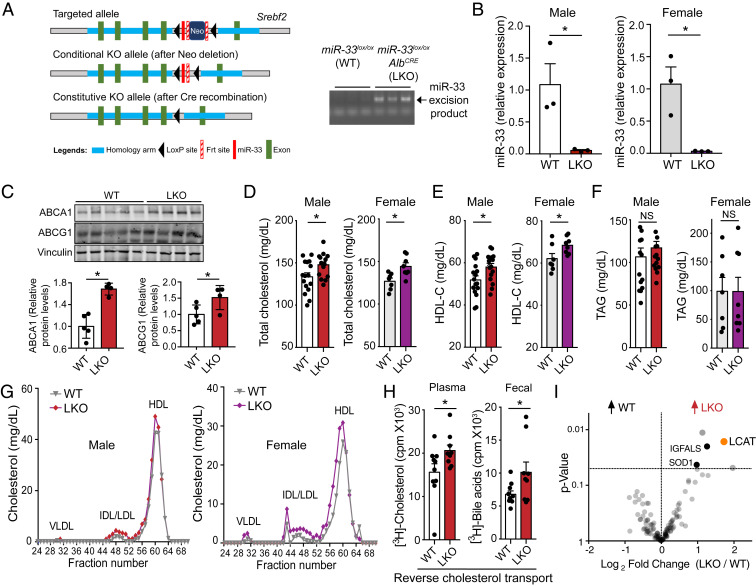Fig. 1.
Loss of miR-33 in the liver increases circulating HDL levels and improves RCT capacity. (A) Schematic diagram depicting the generation of conditional miR-33–knockout mice. The construct is composed of a short flippase recombination enzyme (Flp)-recognition target (FRT), reporter, and a Cre recombinase recognition target (loxP). The first loxP site is followed by the miR-33 coding region, then the first FRT site, the neomycin selection cassette driving the neomycin resistance gene, a second FRT site, and the second loxP site (Top). Mice with the floxed allele but lacking the neo cassette were generated by crossing with flp recombinase-deleter mice (Middle). Subsequently, these mice were bred with mice expressing Cre recombinase to produce tissue-specific miR-33–knockout mice (Bottom). PCR amplification of the excised genomic region containing miR-33 in the liver of LKO mice (Right). (B) qPCR analysis of miR-33 expression in the liver of miR-33loxP/loxP (WT) and miR-33loxP/loxP/AlbuminCre (LKO) animals (n = 3). (C) Representative Western blots and densitometric analysis of ABCA1, ABCG1, and housekeeping standard Vinculin in liver lysates from male WT and LKO mice. (D–F) Levels of total cholesterol (D), HDL-C (E), and TAGs (F) in plasma of WT and LKO mice (male, n = 15 to 16; female, n = 7 to 8). (G) Cholesterol content of FPLC-fractionated lipoproteins from pooled plasma of n = 5 to 8 WT and LKO mice. (H) The [3H]-cholesterol in plasma (Left) and in fecal bile acids (Right) from male WT and LKO mice injected IP with [3H]-cholesterol–labeled BMDMs (n = 9 to 10). (I) Plasma proteome analysis from male WT and LKO mice. The graph indicates the significantly increased proteins found in WT and LKO plasma (n = 5). Data represent the mean ± SEM (*P ≤ 0.05 compared with WT animals).

